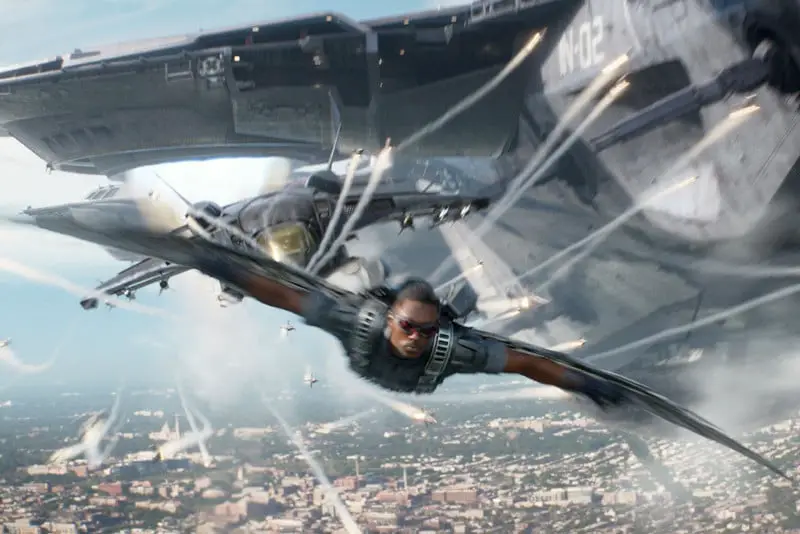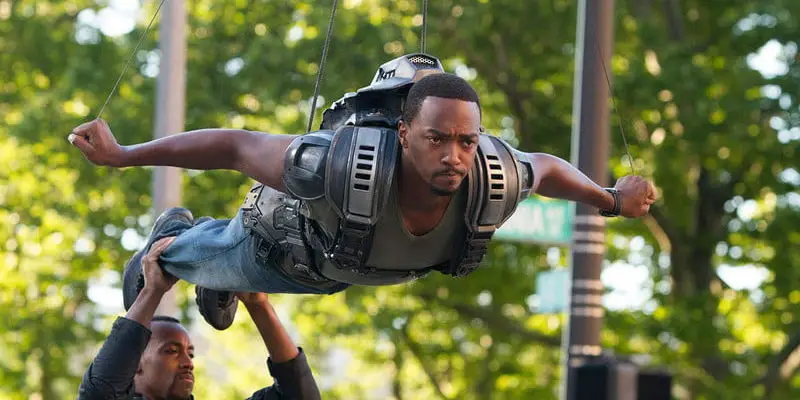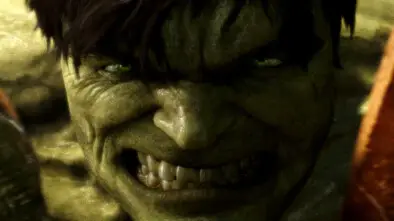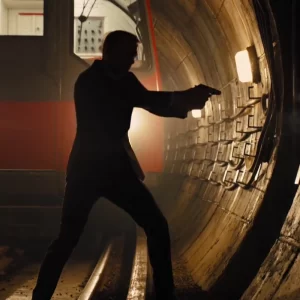Making Falcon Fly In ‘Captain America: The Winter Soldier’
Falcon, the trusty sidekick of Steve Rogers, first took flight in Captain America: The Winter Soldier. Sharing Rogers patriotic duty, the two became fast friends even before Sam Wilson took on the mantle of Falcon, the namesake he took from the experimental winged harness EXO-7 Falcon.
Seeing Falcon take flight, and perform thrilling aerobatic maneuvers was one of the highlights of Winter Soldier. A man with military-designed wings strapped to his back, that can perform somersaults, and bank left and right to avoid mid-air explosions has never been seen on screen before. The VFX team made Anthony Mackie look convincing in those scenes, making the almost inhuman aerial acrobatics look humanly possible. Furthermore, it is largely from Falcon’s perspective that the audience sees the climactic battle involving the destruction of three Helicarriers above Washington D.C.
Each MCU character, whether Iron Man, Hulk, or Thor, presented their own unique set of problems. Making characters that defy regular physics look realistic is pretty much the same dilemma that Marvel’s pool of talented VFX team face every time they are presented with a new script. This time Dan Deleeuw, a veteran VFX supervisor who worked on Iron Man 3, oversaw The Winter Soldier as the film’s production VFX supervisor. It was the beginning of a successful run for Deleeuw who fulfilled the same position on Civil War, Infinity War, and most recently Endgame.
With Falcon, Deleeuw oversaw a complex process that began with planning Falcon’s flight and fight sequences in previz, followed by a combination of stuntwork, wire-work, and the digital mapping of Anthony Mackie’s face onto a virtual stand-in that was then seamlessly stitched into the CG action in post-production.
Getting Falcon’s Maneuvers Right in Previz
Deleeuw’s first requirement was to work out how the winged Avenger would fly, and how he’d look flying and fighting in mid-air. For this task, he turned to Proof, a visualization company specializing in pre-viz and post-viz work. Proof spent 14 months working in previz on Winter Soldier, and another eight months in postviz. They were across every major action and VFX scene, including visualizing how Falcon flies. Proof spent a good deal of their time in previz working on Falcon’s aerial acrobatics in the mid-air climax to Winter Soldier as he and Cap try to change electronic key cards on three S.H.I.E.L.D. helicarriers.

“Developing the animation of Falcon and the helicarriers were the most time-consuming pieces of the film,” Proof’s previs supervisor Monty Granito told Digital Media World. “No one knew how Falcon could fly and look believable, and that needed time to figure out. We ramped up to 15 artists for the bulk of that stage.”
“Falcon’s sequence began as an animation test with an image of Falcon performing a backflip off of the helicarrier. Dan [Deleeuw], the previs artists and I worked out the chase scene until we had a rough version that the directors liked, and they encouraged us to continue fleshing out a sequence with it.”
Proof’s animation test of Falcon and the helicarriers formed the basis of the sequence in the film. “We then sent the scenes to ILM, where they became very close to what is in the final picture. Kudos to ILM – they made Falcon look amazing,” said Granito.
ILM Creates Falcon’s Digital Doubles
ILM was tasked with creating a digital Falcon (among other VFX in the film). They were also charged with creating the aerial battle in and around three helicarriers above Washington D.C. that we see mostly from Falcon’s perspective. The final result on film is impressive, with ILM creating a virtual Washington D.C. environment which allowed for aerial cinematography of the massive aerial battle, in which Falcon is front and center.
This focus on Falcon required ILM to develop photorealistic digital doubles of him.
“We used digital doubles in ways where we might not have used it prior,” said Russell Earl, ILM’s visual effects supervisor on the film. “We did a full scan and photoshoot [with the lead actors] in full costume and built detailed digital doubles. [At one point] I was looking at a shot thinking it was real, and it was actually the digital double — that made us be a little bolder in the use of digital doubles. We used them in some of the close-ups.”
“The character that we did the most work on was Falcon.”
Inserting Anthony Mackie’s Stunt And Wire-Work Into The CG Action
But the film-makers couldn’t just rely on digital doubles. Anthony Mackie stepped in and did a few stunts of his own. Speaking with CBR, the actor said he was required to jump off a 30-foot platform. “The first day, I’m supposed to walk. I’m on this platform, 30 feet in the air, and they put these wires on me. About the 50th time doing it, I say, ‘Don’t I have a stuntman?’ I look back and my stuntman has a comical mound of nachos. He’s like, ‘You’re doing good!’ That was day one.”

Source: Marvel
In addition, Mackie was required for wire-work, which would show him taking off and landing at the beginning or end of some spectacular CG sequences. Then to really sell the CG sequences, digital mapping of Mackie’s face was added to the digital doubles showing close-ups of the actor reacting to the CGI explosions and aerial combat happening around him.
Mackie was placed in a “dome” of cameras which recorded every expression he made from every angle. This ensured that the recorded expressions would match Falcon’s spins, dives, and banking right or left in mid-air.
“There’s only so much you can do to an actor before they just can’t take it anymore,” DeLeeuw told HitFix. “Initially most of the shots with Mackie were close-ups. We’ll shoot the close-up with him on the wire. Some of those shots where we couldn’t get him to hang right, we would just kind of remove his body and just keep his face – so even the close-up shots are digi doubles.”
In the end, the combination of Mackie’s face, wire-work, stunt work, and the digital doubles are seamlessly stitched together. The result is a level of realism that makes it pretty easy to buy into the most fantastical scene in the film.

Source: Marvel




